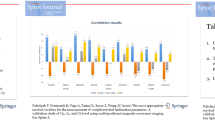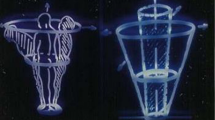Abstract
Objective
To reveal the relation between alignments of upper and subaxial cervical spine and deduce the optimal atlantoaxial fusion angle by a radiological study.
Methods
414 asymptomatic volunteers (213 males, 201 females) underwent cervical lateral radiographs in neutral position. The Oc–C2 angle, C1–C2 angle and C2–C7 angle were measured. Relations among these three angles and relations between angles and age were analyzed.
Results
The mean Oc–C2 angle was 16.3° ± 7.0° in females, significantly larger than 14.9° ± 6.5° in males. The mean C1–C2 angles were 28.2° ± 4.0° in females and 26.4° ± 4.6° in males, and C2–C7 angles were 12.7° ± 6.6° and 16.3° ± 7.3°, correspondingly. The mean C1–C2 angle in females was significantly larger than that in males, while C2–C7 angle smaller than that in males. The C2–C7 angle correlated significantly not only with C1–C2 angle but also with Oc–C2 angle. And correlation between C1–C2 angle and C2–C7 angle was stronger than that between Oc–C2 angle and C2–C7 angle. There were also significant positive correlations between C1–C2 and Oc–C2 angles. Oc–C2 angle, C1–C2 angle, and C2–C7 angle correlated significantly with age in both sexes.
Conclusions
There were negative correlations between C1–C2 angle and C2–C7 angle as well as between Oc–C2 angle and C2–C7 angle, and the former correlation was stronger. C1–C2 fixation angle was the key to regulate postoperative subaxial alignment in atlantoaxial arthrodesis. The optimal atlantoaxial fusion angle may be between 25° and 30°.





Similar content being viewed by others
References
Yoshimoto H, Ito M, Abumi K, Kotani Y, Shono Y, Takada T, Minami A (2004) A retrospective radiographic analysis of subaxial sagittal alignment after posterior C1–C2 fusion. Spine (Phila Pa 1976) 29:175–181. doi:10.1097/01.BRS.0000107225.97653.CA
Matsumoto M, Chiba K, Nakamura M, Ogawa Y, Toyama Y, Ogawa J (2005) Impact of interlaminar graft materials on the fusion status in atlantoaxial transarticular screw fixation. J Neurosurg Spine 2:23–26. doi:10.3171/spi.2005.2.1.0023
Kato Y, Itoh T, Kanaya K, Kubota M, Ito S (2006) Relation between atlantoaxial (C1/2) and cervical alignment (C2–C7) angles with Magerl and Brooks techniques for atlantoaxial subluxation in rheumatoid arthritis. J Orthop Sci 11:347–352. doi:10.1007/s00776-006-1033-x
Takeuchi K, Yokoyama T, Aburakawa S, Ueyama K, Ito J, Sannohe A, Okada A, Toh S (2006) Inadvertent C2–C3 union after C1–C2 posterior fusion in adults. Eur Spine J 15:270–277. doi:10.1007/s00586-005-0940-4
Suda K, Abumi K, Ito M, Shono Y, Kaneda K, Fujiya M (2003) Local kyphosis reduces surgical outcomes of expansive open-door laminoplasty for cervical spondylotic myelopathy. Spine (Phila Pa 1976) 28:1258–1262. doi:10.1097/01.BRS.0000065487.82469.D9
Barsa P, Suchomel P (2007) Factors affecting sagittal malalignment due to cage subsidence in standalone cage assisted anterior cervical fusion. Eur Spine J 16:1395–1400. doi:10.1007/s00586-006-0284-8
Kawaguchi Y, Kanamori M, Ishihara H, Ohmori K, Nakamura H, Kimura T (2003) Minimum 10-year follow-up after en bloc cervical laminoplasty. Clin Orthop Relat Res 129–139. doi:10.1097/01.blo.0000069889.31220.62
Nojiri K, Matsumoto M, Chiba K, Maruiwa H, Nakamura M, Nishizawa T, Toyama Y (2003) Relationship between alignment of upper and lower cervical spine in asymptomatic individuals. J Neurosurg: Spine 99:80–83. doi:10.3171/spi.2003.99.1.0080
McGregor GM (1948) The significance of certain measurements of the skull in the diagnosis of basilar impression. Br J Radiol 21:171–181
Phillips FM, Phillips CS, Wetzel FT, Gelinas C (1999) Occipitocervical neutral position. Possible surgical implications. Spine (Phila Pa 1976) 24:775–778
Matsunaga S, Onishi T, Sakou T (2001) Significance of occipitoaxial angle in subaxial lesion after occipitocervical fusion. Spine (Phila Pa 1976) 26:161–165
Sherekar SK, Yadav YR, Basoor AS, Baghel A, Adam N (2006) Clinical implications of alignment of upper and lower cervical spine. Neurol India 54:264–267
McRae DL, Barnum AS (1953) Occipitalization of the atlas. Am J Roentgenol Radium Ther Nucl Med 70:23–46
Mukai Y, Hosono N, Sakaura H, Fujii R, Iwasaki M, Fuchiya T, Fujiwara K, Fuji T, Yoshikawa H (2007) Sagittal alignment of the subaxial cervical spine After C1–C2 transarticular screw fixation in rheumatoid arthritis. J Spinal Disorders Tech 20:436–441. doi:410.1097/BSD.1090b1013e318030ca318033b
Author information
Authors and Affiliations
Corresponding authors
Rights and permissions
About this article
Cite this article
Guo, Q., Ni, B., Yang, J. et al. Relation between alignments of upper and subaxial cervical spine: a radiological study. Arch Orthop Trauma Surg 131, 857–862 (2011). https://doi.org/10.1007/s00402-011-1265-x
Received:
Published:
Issue Date:
DOI: https://doi.org/10.1007/s00402-011-1265-x




